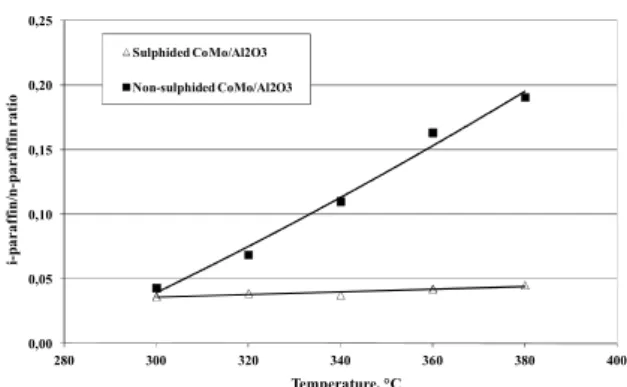Catalysis for Clean Energy and Sustainable Chemistry, 2012.
1
Production of bio gas oil from rancid lard via catalytic hydrogenation on different state CoMo/Al
2O
3catalysts
Peter Baladincz*, Csaba Tóth, Jenő Hancsók
MOL Department of Hydrocarbon and Coal Processing, University of Pannonia, 10. Egyetem str., Veszprém, H-8200, Hungary
*Corresponding author: baladinczp@almos.uni-pannon.hu
Introduction
The modern-minded man had been discovered, that it is necessary to substitute a part of the fossil derived energy sources with renewable energy sources to cover the energy demand of mobility, which sustain and accelerate the human society and economy. Nowadays, the transportation sector tries to achieve this through the development and utilisation of bio derived motor fuels. In terms of Diesel-engines the biodiesel have been utilized in great volumes already, which is made from triglycerides via esterification (fatty-acid- methyl-ester) [1]. The biodiesel, due to its molecular structure, has some unfavourable properties. Therefore it was necessary to develop a new generation of bio derived motor fuel for Diesel-engines. The most promising product of these efforts is the bio gas oil which is a mixture of n- and i-paraffins and obtained via hydroconversion of triglycerides [2,3,4,5]. These compounds are the best components of conventional gas oils, too. Nowadays, as triglyceride source mainly different vegetable oils are used, but as the feedstock for the hydroconversion any feed with high triglyceride content can be used, e.g. brown greases of sewage works, used cooking oils, animal fats, etc.
Experimental
During the experimental work, our aim was to investigate the possibilities of bio gas oil and bio gas oil containing gas oils on waste fat basis via the hydroconversion of waste rancid lard itself and as a 50%
mixture with gas oils. We applied CoMo/Al2O3 catalyst in sulphid and in non-sulphid state. In the course of the experiments, we studied the effects of the process parameters (temperature: 300-380°C, pressure: 40-80 bar, LHSV: 1.0-2.0 h-1, H2/feedstock ratio: 600 Nm3/m3) on the quality and yield of the products. The experiments were carried out in continuous mode in an experimental equipment containing a tubular reactor with 100 cm3 active volume capacity. The yield of the products have been determined on the basis of the amount of feedstocks. The properties of the feedstocks and the obtained gas oil boiling point range main product fractions were specified according to the specifications of the valid diesel fuel standard, and with standardised calculation methods.
Results and Discussion
In the case of mixture feedstocks and sulphide state CoMo/Al2O3 catalyst the yield of the main product fraction (81%) was higher than in the case of non-sulphided state CoMo/Al2O3 catalyst (72%) at the most rigorous process parameters. However in both form (i.e. sulphided and non-sulphided) of the applied catalyst, the yield of the unconverted residual fraction (boiling point >360°C) was significant. The HDO/DCO ratio of the hydroconversion pathways which is favourable to the yield of the main product
Catalysis for Clean Energy and Sustainable Chemistry, 2012.
2
fraction was higher in the case of non-sulphided catalyst than in case of the sulphided catalyst. The isoparaffin content of the main product fractions (high isoparaffin content is favourable to the good cold flow properties) was the highest in the case of non-sulphided state CoMo/Al2O3 catalyst, because of the high isomerisation activity of the non-sulphided CoMo bimetallic system.
0 10 20 30 40 50 60 70 80 90
280 300 320 340 360 380 400
Yield of the main product fraction, %
Temperature, °C
100% lard, sulphided CoMo/Al2O3 100% lard, non-sulphided CoMo/Al2O3 50% lard, sulphided CoMo/Al2O3 50% lard, non-sulphided CoMo/Al2O3
Figure 1. Yield of the main product fractions as a function of the temperature in the case of different
feedstocks and state of catalyst (P: 80 bar; LHSV: 1.0 h-1; H2/feedstock ratio 600 Nm3/m3)
0 2 4 6 8 10 12 14 16 18 20
0,5 1,0 1,5 2,0 2,5 3,0
280 300 320 340 360 380 400 HDO/DCO ratio on non-sulphided catalyt
HDO/DCO ration on sulphided catalyst
Temperature, °C
Sulphided CoMo/Al2O3 Non-sulphided CoMo/Al2O3
Figure 2. The change in the ratio of the different routes of hydroconversion as a function of the
temperature (P: 80 bar; LHSV:1.0 h-1; H2/ feedstock ratio: 600 Nm3/m3)
0,00 0,05 0,10 0,15 0,20 0,25
280 300 320 340 360 380 400
i-paraffin/n-paraffin ratio
Temperature, °C Sulphided CoMo/Al2O3
Non-sulphided CoMo/Al2O3
Figure 3. The change in the iso- and normal paraffin content of the products as a function of the temperature (P: 80 bar; LHSV: 1.0 h-1; H2/feedstock ratio: 600 Nm3/m3)
References
1. J. M. Marchetti, V. U. Miguel, A. F. Errazu, Renewable and Sustainable Energy Reviews, vol. 11, pp. 1300–1311, 2007.
2. A. Corma, G. W. Huber, P. O’Connor, Applied Catalysis A: General, vol. 329, pp. 120-129, 2007.
3. M. Krár, A. Thernesz, Cs. Tóth, T. Kasza, J. Hancsók, in: Silica and Silicates in Modern Catalysis, I. Halász, Ed., Transworld Research Network, Kerala, India, pp. 435-455.
4. J. Mikulec, J. Cvengros, L. Joríková, M. Banic, A. Kleinová, Journal of Cleaner Production, vol. 18, no. 9, pp. 917-926, 2010.
5. M. Krár, S. Kovács, D. Kalló, J. Hancsók, Bioresource Technology, vol. 101, pp. 9287-9293, 2010.
